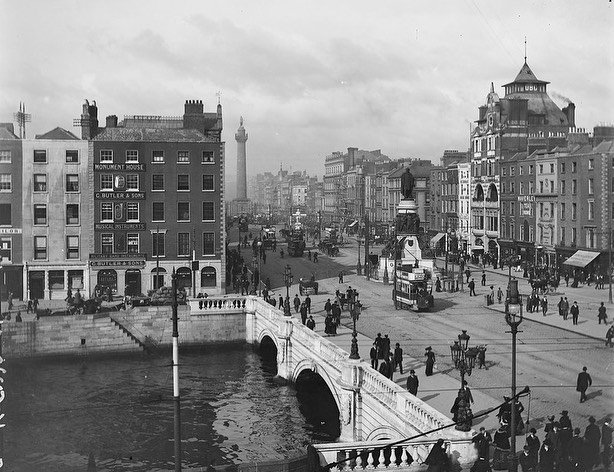In the vast archives of the National Library in Dublin lie photographic treasures that transport us to bygone eras, offering a glimpse into our social history. I found these two captivating images, that not only freeze moments in time, but also tell compelling stories of Ireland's past. It’s one of my favourite areas of research for my late-Victorian dual timeline mystery novels and I could spend hours searching through this period. As they say, a picture tells a thousand words.
O’Connell Bridge
The first photograph captures the iconic O'Connell Bridge in Dublin in 1902, with the monument dedicated to Daniel O'Connell close behind, and Nelson's Pillar in the background.
The O'Connell monument, unveiled on August 15th, 1882, takes centre stage at the bottom of O’Connell Street, commemorating the 'Liberator' and his contributions to Irish political and social life. The monument's towering presence reflects the affection and esteem held for O'Connell, a key figure in the fight for Catholic emancipation. It is as popular a place for friends to meet today as it undoubtedly was back in the late 19th century. I love the bustle of the street, the electric trams (very modern back then), the pedestrians and carriage-horses.
In a way, this old photograph of Dublin serves as a visual time capsule, preserving the most famous of the city’s streets, sixty-four years before a pivotal moment in its history.
Nelson’s Pillar
In the background of the photograph, Nelson's Pillar stands tall and proud. Another popular meeting place, I believe, but one I am too young to remember. Exactly 161 years after the Battle of Trafalgar, O’Connell Street was destined to change dramatically. On March 8th, 1966, at exactly 1.32 a.m., Vice Admiral Horatio Nelson was toppled from his perch when it was blown up by the Irish Republican Army (IRA).
Nowadays we have the Spire in its place, a modern metallic structure.
Waterford Shop Front
1916 was certainly a turbulent year in Irish politics with the Easter Rising, but life goes on in this photograph of a shop front in the city of Waterford in the south of Ireland. I love looking at all the products for sale in the window and some of them are still with us today. Perhaps Fry’s chocolate was a bigger seller than its rival Cadbury’s in this particular area! Fry’s drinking cocoa was popular when I was growing up and, as far as I remember, it came in a yellow tin. Correct me if I’m wrong!
The big confectionary firms from Britain were originally owned by Quakers, an interesting fact. Cadbury’s of Birmingham, Rowntree’s of York, Fry’s of Bristol and also the biscuit manufacturers W & R Jacob and Co., the latter having its origins in Waterford city, were all firms started by members of The Religious Society of Friends. The very first Jacob’s biscuit factory opened here, where the family made what were called ‘Ship Biscuits’, a hard, long-lasting biscuit that sailors took with them on their voyages across the globe from Waterford harbour.
What adds a unique touch to this snapshot of an era frozen in time is the pricing displayed in shillings and pence, a currency system that vanished with the arrival of the decimal system in February 1971. I can remember my brothers’ and my pocket money being 6d a week each. We wouldn’t get much for that now!
Connection Across Eras
While seemingly unrelated, these two photographs share a connection through the overarching theme of Irish social history. O'Connell Bridge and the Waterford shop front stand as symbols of a nation in flux, clinging onto its past and yet attempting to navigate the uncertainties of the future.
(Photographs from the National Library, Dublin on Flickr, where they are copyright free to download)
Suzanne Winterly is the author of mystery and dual timeline historical mystery novels set in the late 19th century and in the present. More details below:
For more about books, stories and photographs, author research, history and gardening, join Suzanne’s newsletter here:

